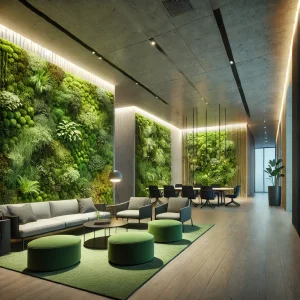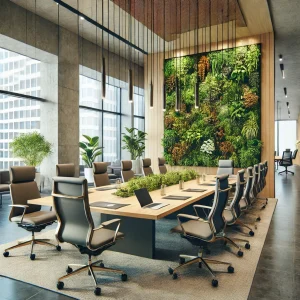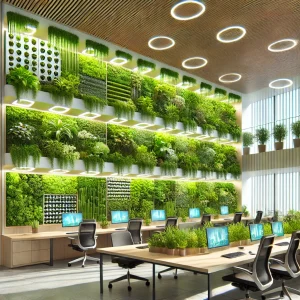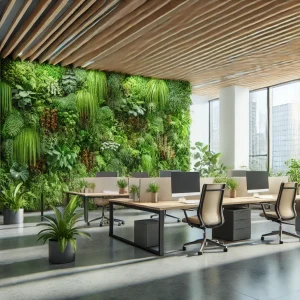Office designers and managers increasingly turn to green walls, or living walls, to create healthier and more productive work environments. These vertical gardens bring a touch of nature indoors and significantly improve indoor air quality. This blog explores the multifaceted benefits of green walls in office settings, backed by scientific research and real-world examples while providing practical tips for implementation.

The Benefits of Green Walls in Offices
Enhanced Air Quality
One of the primary benefits of green walls is their ability to improve air quality. Plants naturally filter airborne toxins, releasing oxygen and absorbing carbon dioxide. A study by NASA found that certain plants can remove up to 87% of air toxins in 24 hours. Common office pollutants like formaldehyde, benzene, and trichloroethylene, often emitted from office furniture and equipment, can be significantly reduced by incorporating green walls.

Aesthetic and Psychological Benefits
Beyond improving air quality, green walls add aesthetic value to office spaces. They create visually appealing environments that can reduce stress and enhance overall well-being. Studies have shown that exposure to nature, even indoor plants, can improve mood, reduce anxiety, and increase cognitive function. This can lead to increased productivity and creativity among employees.

Real-World Examples
Several companies have successfully integrated green walls into their office designs, reaping the benefits of cleaner air and improved employee morale.
- Amazon Spheres, Seattle: These massive glass domes are home to over 40,000 plants worldwide. The living walls inside the spheres provide a unique, lush environment supporting employee well-being and creativity.
- Pasona Group, Tokyo: This recruitment company’s headquarters features extensive green walls, which purify the air and provide fresh produce for the company cafeteria. This innovative use of space promotes sustainability and employee health.
- Akamai Technologies, Cambridge: Their office includes several green walls that improve air quality and create a relaxing atmosphere for employees. Incorporating plants into their workspace design has been part of their broader commitment to sustainability and employee wellness.

Scientific Support
The benefits of green walls are well-documented. A study published in the Journal of Environmental Psychology found that office environments with plants could increase productivity by 15%. Additionally, research from the University of Technology Sydney demonstrated that indoor plants could reduce indoor air pollutants by up to 75%.

Types of Green Walls
Various green walls can be tailored to fit different office environments:
- Moss Walls: Moss walls are low-maintenance and ideal for low-light areas. Moss walls are great for offices looking to add a touch of greenery without extensive upkeep.
- Vertical Gardens: These are more traditional living walls that use a variety of plants. They often require more maintenance but offer the most significant benefits regarding air purification and aesthetic appeal.
- Hydroponic Walls: Utilizing water and nutrient solutions instead of soil, these walls can be more space-efficient and offer innovative design possibilities.
Implementation Tips
Implementing green walls in an office space requires careful planning. Here are some tips to get started:
- Assess the Space: Determine where the green wall will be most effective and aesthetically pleasing. Consider factors like natural light, available space, and existing design elements.
- Choose the Right Plants: Select plants known for their air-purifying qualities, such as spider plants, snake plants, and peace lilies. Ensure the chosen plants are suitable for indoor environments.
- Plan for Maintenance: Regular maintenance is crucial for the health of the plants. This includes watering, pruning, and monitoring for pests. Some companies opt for professional maintenance services.
- Consider Costs: While the initial investment for installing a green wall can be high, the long-term benefits of employee health and productivity often outweigh the costs. Additionally, green walls can contribute to energy savings by providing natural insulation.

Costs and Maintenance
The cost of green walls varies depending on the size, type of plants, and installation complexity. Initial costs can range from $100 to $500 per square foot. However, the long-term savings on energy bills and the potential for increased productivity make it a worthwhile investment. Maintenance costs should also be factored in, which can be minimized by choosing low-maintenance plant varieties and automated watering systems.
Green walls are more than just a design trend; they are a practical solution for improving indoor air quality and creating healthier, more productive office environments. By incorporating living walls, companies can enhance employee well-being, promote sustainability, and enjoy the aesthetic and psychological benefits of bringing nature indoors. With careful planning and investment, green walls can become a valuable addition to any office space.